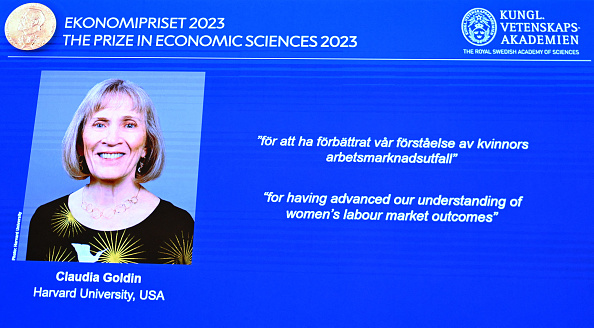Nobel Prize in Economics Awarded to Harvard’s Claudia Goldin for Work on Gender Gaps
Economic historian and labour economist has tracked the changing fortunes of women in the workplace
BOSTON—Harvard University’s Claudia Goldin is a labor economist, teacher and mentor. She is now also a Nobel Prize winner for her groundbreaking research on women in the workforce.
Goldin was awarded the Nobel Prize in Economic Sciences on Monday, the third woman to receive the economics prize since the award started in 1969. The 77-year-old Harvard economist has spent decades analysing troves of data to produce research illuminating the history of women’s job-market experiences.
Goldin’s expansive work portfolio includes pieces on the drivers of female labor-force participation, the origins of the gender pay gap and hiring biases against women. Her paper, “Why Women Won,” which documented the evolution of women’s legal rights, published this month.

“Goldin’s discoveries have vast societal implications,” said Randi Hjalmarsson, professor of economics at the University of Gothenburg in Sweden.
Goldin was admittedly tired upon entering Monday’s press conference at Harvard. She was, after all, asleep when she received the early-morning call with the news of her Nobel Prize. Still, her passion regarding decades of research and relationship-building radiated as she spoke at a press briefing.
“The increase of women in economics is important for a host of reasons,” Goldin said. “For me personally it has been important because I have had the most wonderful co-authors.”
One such co-researcher, Claudia Olivetti of Dartmouth College, said Goldin’s body of work has shaped much of the current research on women and labor markets. Perhaps less well known, Olivetti said, is Goldin’s extraordinary mentorship of women.
Goldin “has been a source of inspiration to many women in economics, generously sharing her experiences and demonstrating the possibilities of success,” Olivetti said.
Some professors view themselves as researchers, rather than teachers. Not Goldin.
“I could never do research without doing teaching,” she said. “When I teach, I am forced to confront what I think is the truth.”
Goldin was the first woman to secure tenure in Harvard’s economics department. She follows Esther Duflo in 2019 and Elinor Ostrom in 2009 as female recipients of the economics Nobel Prize.
Goldin is married to Lawrence Katz, also a Harvard economist. Both are avid bird watchers and hikers, colleagues said. She has a 13-year-old golden retriever named Pika and no children.
Around the world, 50% of women have paid jobs, compared with 80% of men, although that gap is smaller in advanced economies. Across the developed economies, women earn 13% less on average and are less likely to play senior roles in the organisations they work for.
Goldin’s research questioned the assumption that women had steadily, or would inevitably, narrow those gaps. Using data that had previously attracted little attention, she established that far fewer women worked in paid employment in the early 1900s than in 1800, while that share rebounded as the 20th century advanced, albeit slowly.
Her writing includes 1990’s “Understanding the Gender Gap: An Economic History of American Women.” Examining 200 years of data, Goldin tracked the changing fortunes of women in the workplace as it changed from farm to factory to office.
She also identified some of the considerations that affected the decisions made by women about their participation in the workforce, as well as the constraints they faced at particular times. In one well-known paper, she examined the effect of the contraceptive pill on decisions about work and marriage.
The pay gap between male and female workers had long been attributed to differences in educational attainment, with women typically spending fewer years in formal education.
But that can no longer be true of many developed countries, where women are now better educated on average than men. Instead, Goldin’s work indicates that the gap in pay occurs with the birth of a first child, with women typically devoting more time to child care.
But darker forces are also at work. In one paper, Goldin and co-author Cecilia Rouse from Princeton University showed that the number of female members of the leading U.S. symphony orchestras rose sharply in the 1980s partly because of the adoption of “blind” auditions, where the candidate for an orchestra position auditioned behind a screen, concealing their gender or race from those doing the hiring.
In their paper, called “Orchestrating Impartiality: The Impact of ‘Blind Auditions’ on Female Musicians,” the authors found data across decades of hiring by symphonies both before and after the introduction of blind auditions to show that about a quarter of the increase in female members of orchestras over that time was due to blind auditions, suggesting previous bias.
 Copyright 2020, Dow Jones & Company, Inc. All Rights Reserved Worldwide. LEARN MORE
Copyright 2020, Dow Jones & Company, Inc. All Rights Reserved Worldwide. LEARN MORE
This stylish family home combines a classic palette and finishes with a flexible floorplan
Just 55 minutes from Sydney, make this your creative getaway located in the majestic Hawkesbury region.
When will Berkshire Hathaway stop selling Bank of America stock?
Berkshire began liquidating its big stake in the banking company in mid-July—and has already unloaded about 15% of its interest. The selling has been fairly aggressive and has totaled about $6 billion. (Berkshire still holds 883 million shares, an 11.3% interest worth $35 billion based on its most recent filing on Aug. 30.)
The selling has prompted speculation about when CEO Warren Buffett, who oversees Berkshire’s $300 billion equity portfolio, will stop. The sales have depressed Bank of America stock, which has underperformed peers since Berkshire began its sell program. The stock closed down 0.9% Thursday at $40.14.
It’s possible that Berkshire will stop selling when the stake drops to 700 million shares. Taxes and history would be the reasons why.
Berkshire accumulated its Bank of America stake in two stages—and at vastly different prices. Berkshire’s initial stake came in 2017 , when it swapped $5 billion of Bank of America preferred stock for 700 million shares of common stock via warrants it received as part of the original preferred investment in 2011.
Berkshire got a sweet deal in that 2011 transaction. At the time, Bank of America was looking for a Buffett imprimatur—and the bank’s stock price was weak and under $10 a share.
Berkshire paid about $7 a share for that initial stake of 700 million common shares. The rest of the Berkshire stake, more than 300 million shares, was mostly purchased in 2018 at around $30 a share.
With Bank of America stock currently trading around $40, Berkshire faces a high tax burden from selling shares from the original stake of 700 million shares, given the low cost basis, and a much lighter tax hit from unloading the rest. Berkshire is subject to corporate taxes—an estimated 25% including local taxes—on gains on any sales of stock. The tax bite is stark.
Berkshire might own $2 to $3 a share in taxes on sales of high-cost stock and $8 a share on low-cost stock purchased for $7 a share.
New York tax expert Robert Willens says corporations, like individuals, can specify the particular lots when they sell stock with multiple cost levels.
“If stock is held in the custody of a broker, an adequate identification is made if the taxpayer specifies to the broker having custody of the stock the particular stock to be sold and, within a reasonable time thereafter, confirmation of such specification is set forth in a written document from the broker,” Willens told Barron’s in an email.
He assumes that Berkshire will identify the high-cost Bank of America stock for the recent sales to minimize its tax liability.
If sellers don’t specify, they generally are subject to “first in, first out,” or FIFO, accounting, meaning that the stock bought first would be subject to any tax on gains.
Buffett tends to be tax-averse—and that may prompt him to keep the original stake of 700 million shares. He could also mull any loyalty he may feel toward Bank of America CEO Brian Moynihan , whom Buffett has praised in the past.
Another reason for Berkshire to hold Bank of America is that it’s the company’s only big equity holding among traditional banks after selling shares of U.S. Bancorp , Bank of New York Mellon , JPMorgan Chase , and Wells Fargo in recent years.
Buffett, however, often eliminates stock holdings after he begins selling them down, as he did with the other bank stocks. Berkshire does retain a smaller stake of about $3 billion in Citigroup.
There could be a new filing on sales of Bank of America stock by Berkshire on Thursday evening. It has been three business days since the last one.
Berkshire must file within two business days of any sales of Bank of America stock since it owns more than 10%. The conglomerate will need to get its stake under about 777 million shares, about 100 million below the current level, before it can avoid the two-day filing rule.
It should be said that taxes haven’t deterred Buffett from selling over half of Berkshire’s stake in Apple this year—an estimated $85 billion or more of stock. Barron’s has estimated that Berkshire may owe $15 billion on the bulk of the sales that occurred in the second quarter.
Berkshire now holds 400 million shares of Apple and Barron’s has argued that Buffett may be finished reducing the Apple stake at that round number, which is the same number of shares that Berkshire has held in Coca-Cola for more than two decades.
Buffett may like round numbers—and 700 million could be just the right figure for Bank of America.
This stylish family home combines a classic palette and finishes with a flexible floorplan
Just 55 minutes from Sydney, make this your creative getaway located in the majestic Hawkesbury region.






















